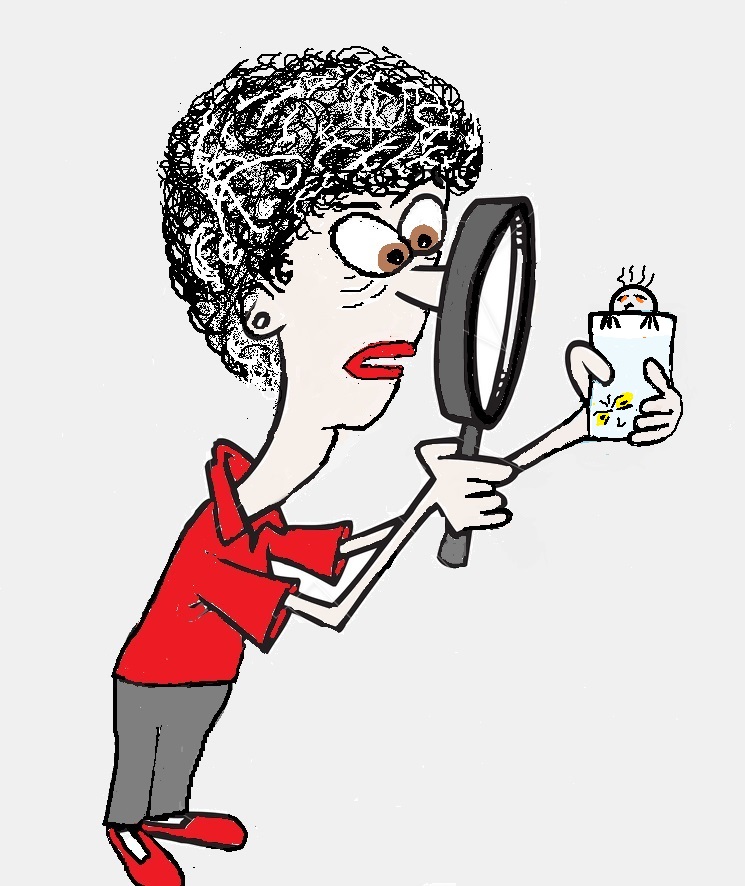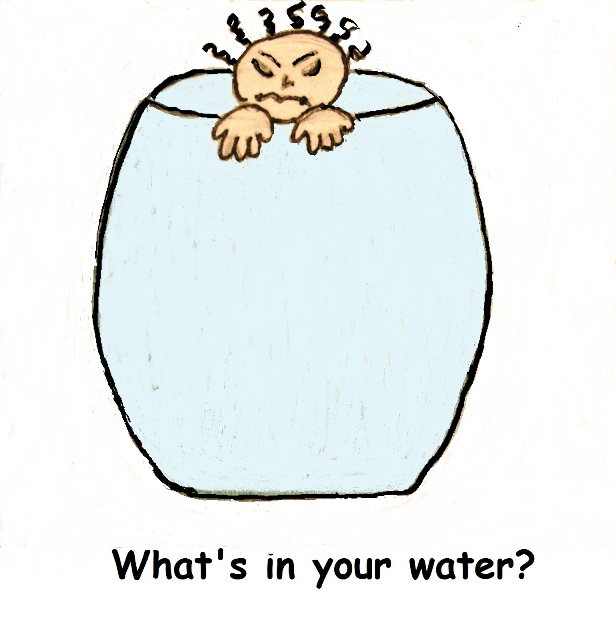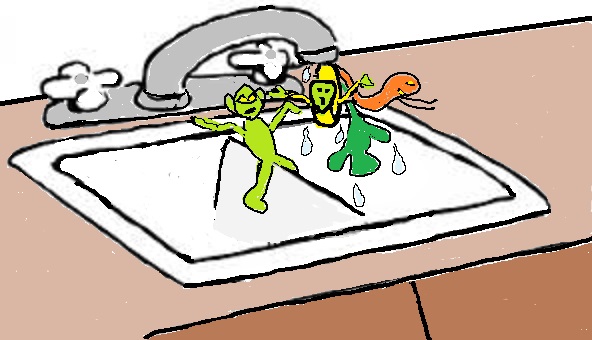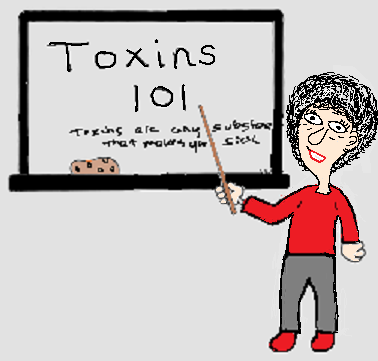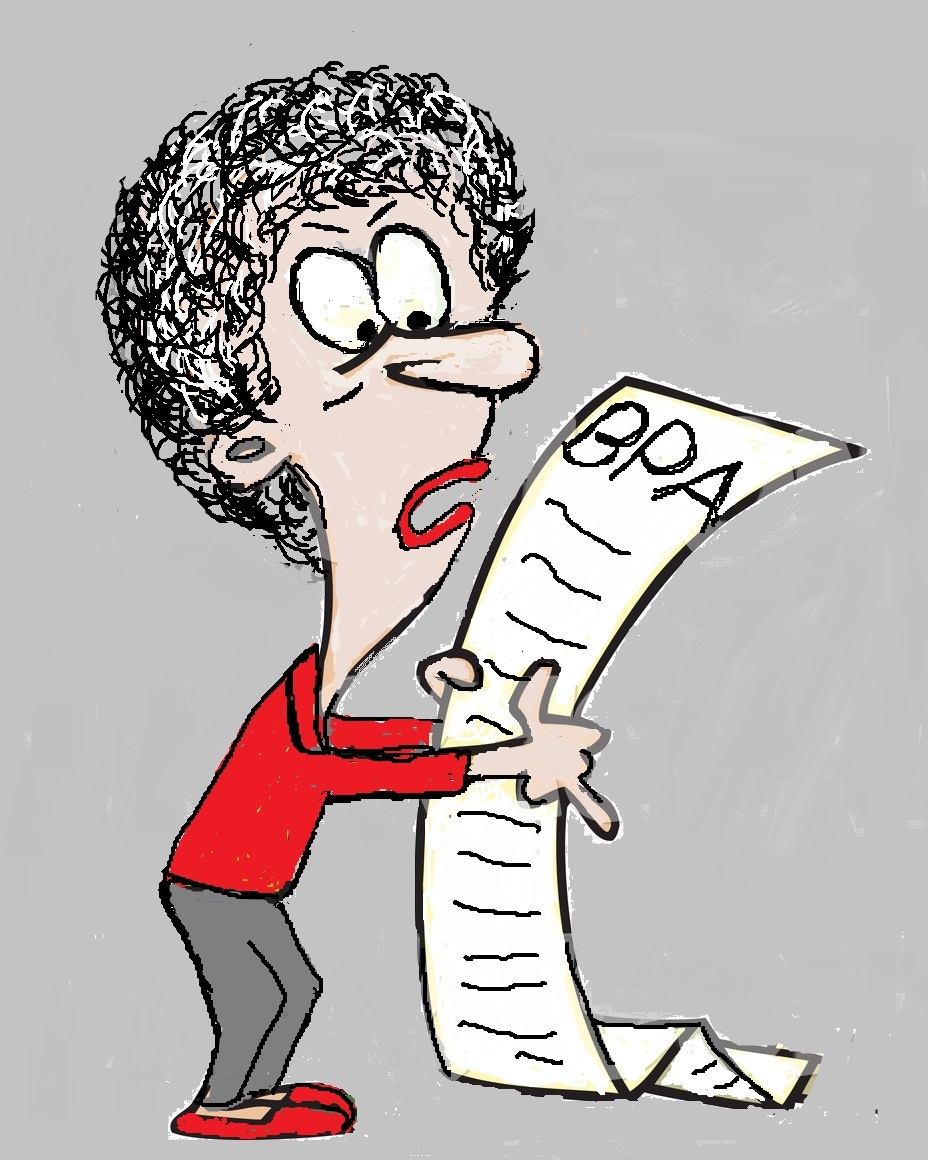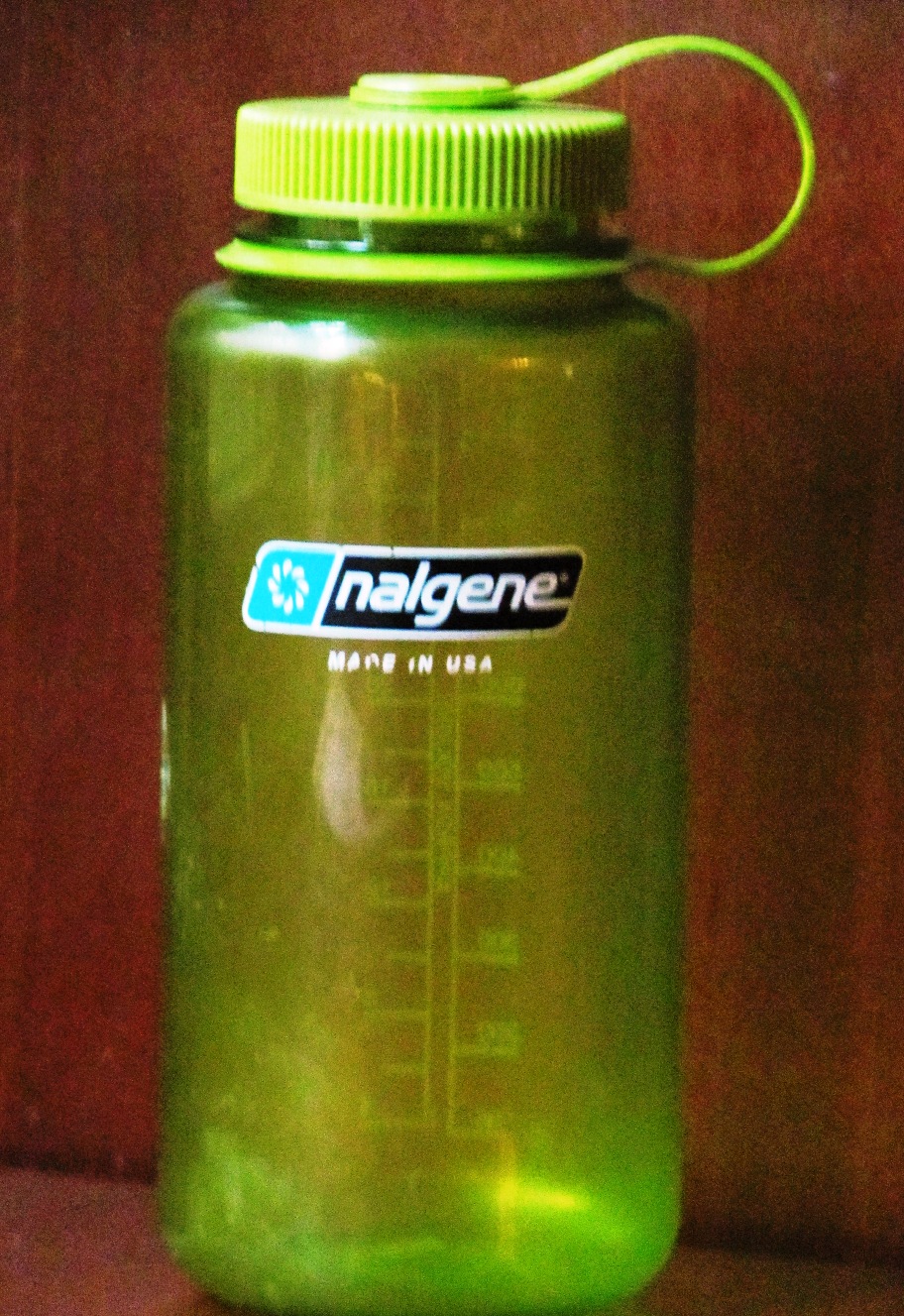- Home
- Toxic Chemicals in Food
- Contaminated Water
How To Find Out If You're Drinking Contaminated Water
Do you know if you're drinking contaminated water? Do you worry about drinking the water that comes out of your tap? Well, ya should be.
Because, according to a 2017 report by the National Resource Defense Council, 77 million Americans get their tap water from community water systems that had one or more drinking water safety violations in 2015. That means one in four Americans is drinking water that doesn’t meet Safe Drinking Water Act standards.
In fact, 267 toxins were found in U.S. drinking water systems between 2010-2015, according to an Environmental Working Group 2017 report. The offenses ranged from high levels of arsenic and disinfection byproducts, to nitrate contamination. The five states with the most violations were Texas, Florida, Pennsylvania, New Jersey and Georgia.
If your water comes from a well, you also need to read this article. You'll learn a lot about what could be in your water by learning about the water contaminants that are detected by the public water systems in your area.
Finding out the contaminates in your drinking water is important because you need water to survive. And you need clean water to stay healthy. So take 30 minutes out of your day to go through the steps listed here to find out if you're drinking contaminated water.
It will be the best 30 minutes you ever spent to protect your health. Because, when it comes to toxic chemicals, regular exposure to even low levels can affect your health. And since you drink from the same taps every day, you're exposed to the same, possibly contaminated, water every day.
Common Tap Water Contaminants
And everything
from sunscreen chemicals to pills, pesticides and phthalates may be in your tap
water. The types of toxins found in water are the result of a variety of
factors, like where you live, weather events, nearby industries and
agriculture and even the type of soil.
Here is a partial list of common tap water contaminants and their health effects.
- Arsenic - a carcinogen and endocrine disruptor
- Benzene - carcinogen
- BPA - endocrine disruptor
- Chromium-6 - one
of the top 5 carcinogens in water
- Haloacetic
Acids - liver,
kidney, central nervous system problems, bladder cancer.
- Lead - damage to brain, kidneys, bone marrow and nervous system.
- Nitrates - bladder, colon, kidney, ovarian cancer, one of top 5 carcinogens in water.
- 1,4-Dioxane - one of the top 5 carcinogens in water.
- PFAS's - endocrine disruptors, possible carcinogens
- Trihalomethanes - one of the top 5 carcinogens in water.
The Reasons Why Your Drinking Water May Be Contaminated
- Many drinking water facilities need to be updated with modern water treatment technologies.
- Quarterly and annual sampling by water systems is inadequate because the levels of some contaminants will fluctuate with the seasons.
- The EPA sets a contaminant limit for completely safe drinking water, and then sets a looser standard for treatment of tap water that accounts for feasibility and costs—and isn’t necessarily safe.
- Many of the contaminants found in tap water are unregulated.
- More than 15 million US households are served by private water wells that are not monitored for any toxins.
- Cleaning water to make it drinkable can result in the formation of more than 700 harmful, DNA-damaging or cancer-causing byproducts. These byproducts form when disinfectants (chlorine, chloramines, chlorine dioxide) react with organic pollution from agriculture or urban and sprawl runoff.
How To Find Out If Your Drinking Water Is Contaminated
The first step to finding out if you're drinking contaminated water is to go to the Environmental Working Group Tap Water Database. You'll find info here on the water treatment companies that provide water to homes in your area.
The database also has info on the chemicals detected in your area's water from 2011-2015. And it shows how many quarters per year water companies were in violation. That means chemical levels in tap water were too high.
So click on this link and type in your zip code.
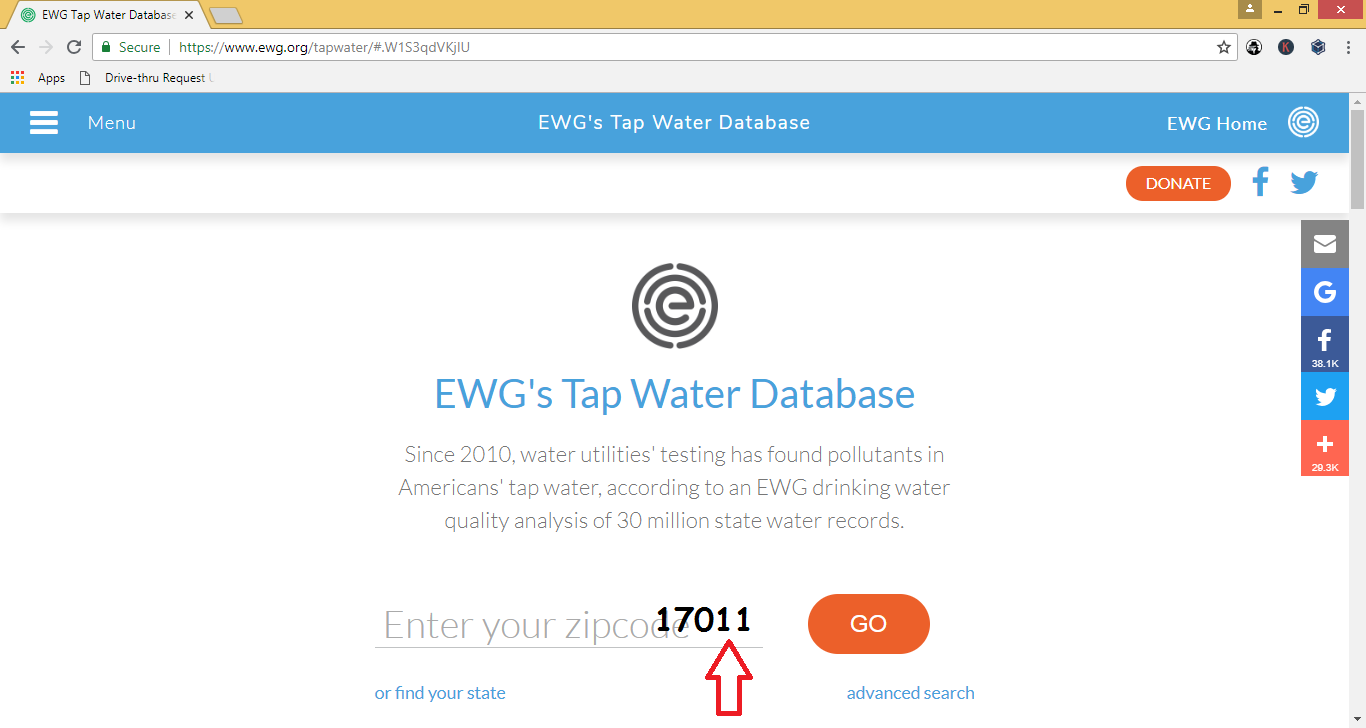
After you enter your zip code you'll see a list of water treatment companies that supply drinking water in your area. Click on your supplier.
If you have a well, choose the water company closest to your home.
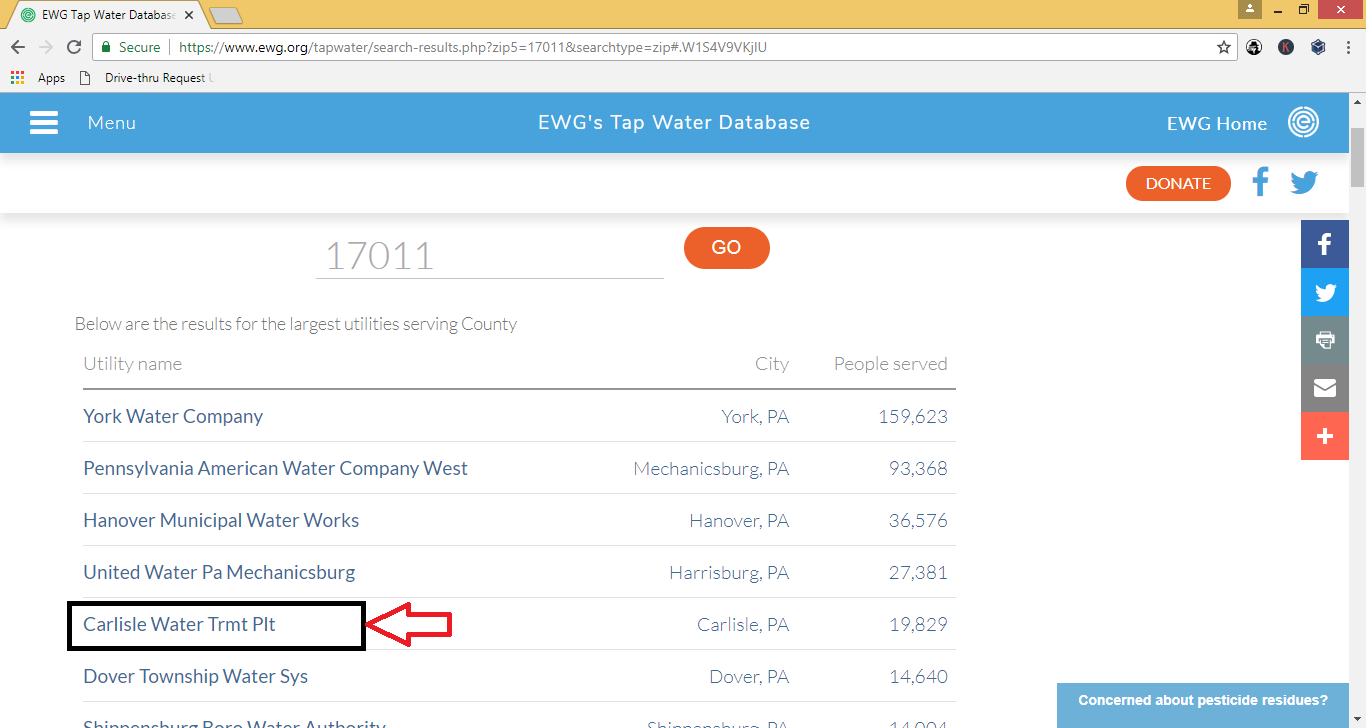
After you click on your water company you'll see a page with the number of chemicals that showed up in your water at unsafe levels. In this example there were 5.
Below the number you'll find the list of chemicals.
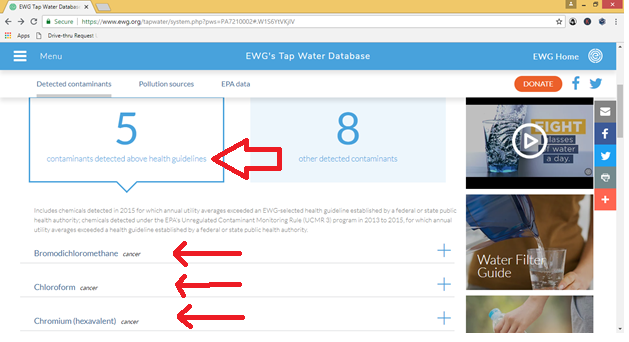
Click on the first chemical to see how often it shows up in your water at unsafe levels. In this example the first chemical is bromodichloromethane.
Bromodichloromethane is a byproduct of the disinfection process. That means it's created and ends up in your tap water during the disinfection and cleaning of the source water that will eventually come out of your tap.
Below the information on the contaminant you'll see how the levels in your area compare to the levels state and nationwide.
The bottom arrow is pointing to the levels found in tap water from the Carlisle Treatment plant. The level is way above state and national levels at 750 ppb (parts per billion).
Bromodichloromethane is part of a group of disinfection byproducts called trihalomethanes.
Exposure to trihalomethanes in drinking water has been linked to liver, kidney or central nervous system problems, and to increased risk of bladder cancer.
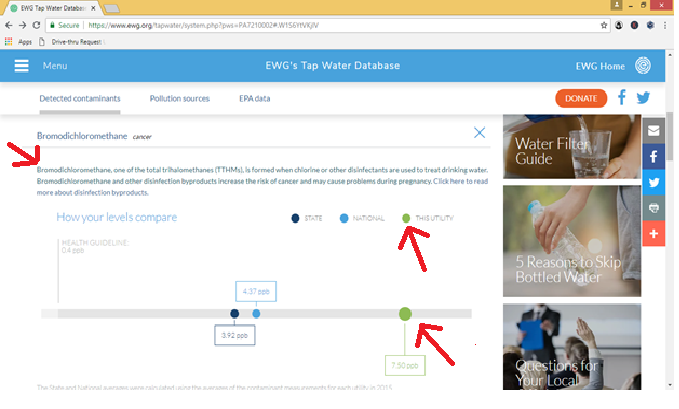
Scroll down to find out how often your water company exceeded the limit for this contaminant.
Testing is done once every 3 months. You can see from the graph that levels were too high for every quarter from the end of 2011 through 2015.
Go through each of the chemicals that were detected and make a list. The list will help you find a water filter that removes these chemicals.
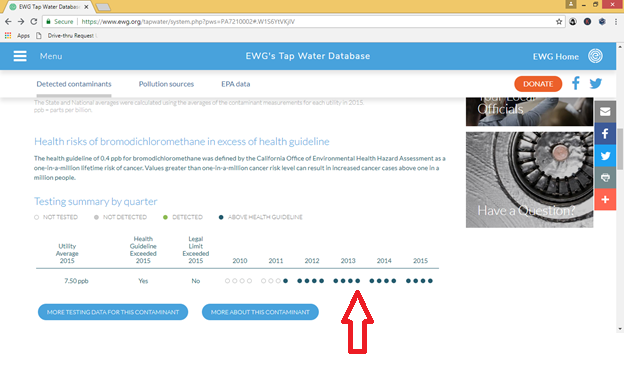
Next, click on the right-hand list of chemicals that were also detected, but at levels below health guidelines. Remember, health and EPA guidelines are usually inadequate for protecting your health.
So you'll also want to read about and make a list of these contaminants.
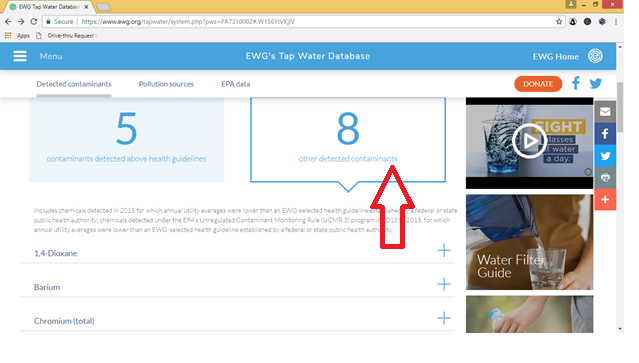
In this example the first contaminant is 1,4-Dioxane. And for this treatment plant the detection level was below state and national averages.
But it is a carcinogen so any level is unacceptable.
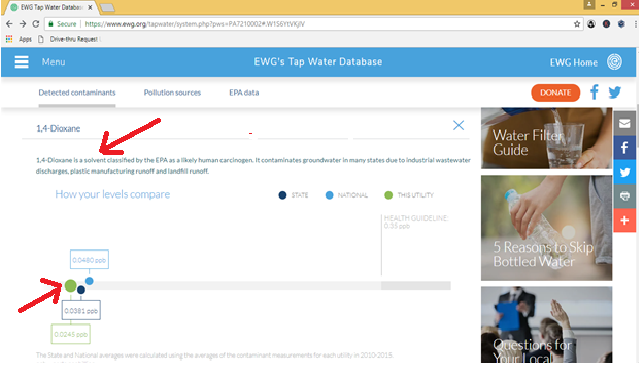
Scroll down the page to see how often it's been detected. You can see from this example that it's been detected in 4 quarters since 2010.
Go through each of the chemicals that were detected and add them to your list.
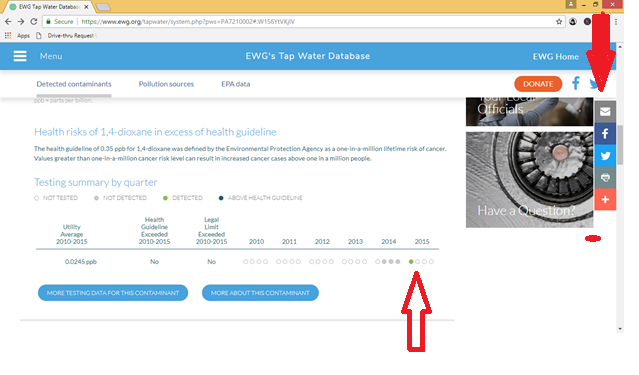
Scroll down to the bottom of the page and click on “Other
Contaminants Tested” to see a list of contaminants that were tested for but not found in your
drinking water.
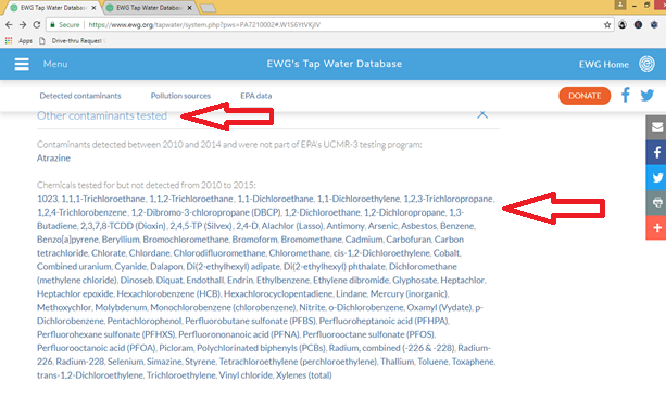
You now how information on the contaminants found in your water through 2015. If you want more updated info you'll have to visit the website of your water supplier and download the annual report.
(If you're happy with the info you have, you can skip this part and move to the Finding The Best Water Filter section.
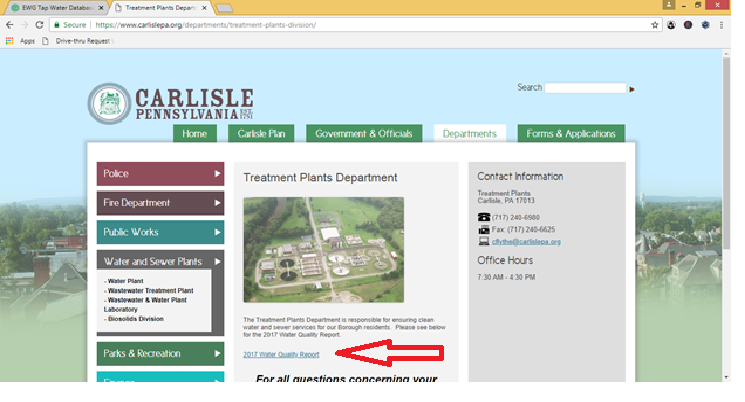
Scroll down to the water quality table. The key items to review include:
- Contaminant – Refers to the particular substance being analyzed in the water, such as lead.
- Unit – Refers to the unit of measurement in which a particular contaminant is being reported, such as parts per million (ppm).
- MCLG – Maximum contaminant level goal. Indicates the minimum level of a contaminant allowed in drinking water below which there is no known or expected risk to health.
- MCL – Maximum contaminant level. Indicates the highest level of contaminant allowed in drinking water.
- Amount detected – The level at which the contaminant was detected in your water supply reported either as an average for the year or as a range.
- Violation – A yes in this column indicates your community had a contaminant present in the water that exceeded an MCL.
***The MCLs are set by the state and the EPA. They are usually set too high to protect your health. So no violation doesn't mean health guidelines are met.
- Source – This column indicates the potential source of a particular contaminant, such as naturally present, an additive or the result of contamination from a particular form of business.
Comparing Your Water Results
To determine if a particular contaminant is present in your drinking water at a level that is near or exceeds federal or state guidelines, compare the level shown in the "Amount Detected" column to the level shown in the "MCL" column.
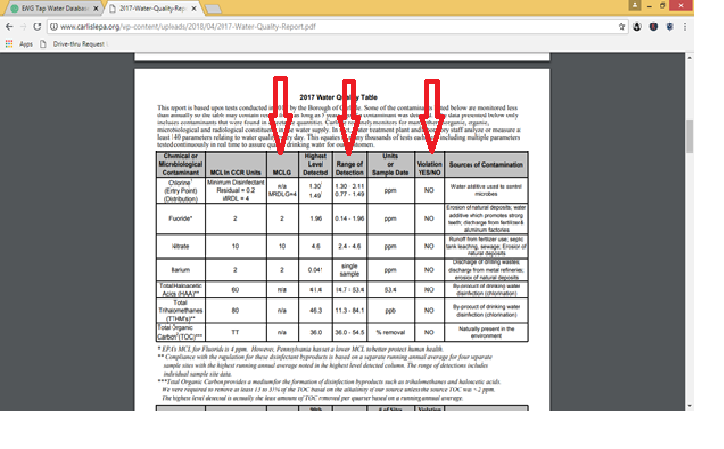
You can also find out the source of your drinking water. In this example it is the Conodoguinet Creek.
The report also identifies the main sources of water contaminants. In this example they are from agricultural crops and livestock and urban runoff.
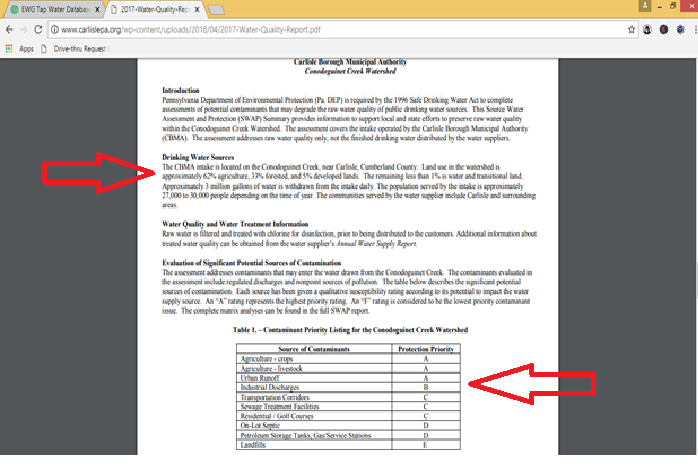
Finding The Best Water Filter
After completing these steps you now know if you're drinking contaminated water. If you are, there is something you can do about it to protect your health.
But the solution isn't to drink bottled water. Plastic water bottles leach several types of endocrine disrupting chemicals into your water. And sometimes bottled water is just glorified tap water.
So the best next step is to decide what type of filter you want to clean up your contaminated water. Then, once you decide on the type of filter, you can identify the specific brand that will remove the contaminants in your water.
Types Of Water Filters
|
Pitcher Filters |
Pros - cheap, easy to maintain, no plumbing required. The best ones remove at least 60 contaminants. Cons - have to remember to fill the pitcher, inconvenient for large families. |
|
Countertop Electric Distillers |
Pros - no plumbing required. The best ones remove most contaminants. Cons - expensive, difficult to maintain, have to remember to fill and run the distiller. Need to re-mineralize drinking water. |
|
Faucet Filters |
Pros - cheaper than whole house, easy to maintain, no plumbing required. The best ones remove from 60-70 contaminants. Cons - leaks are often a problem, frequent filter changes |
|
Under The Sink |
Pros - cheaper than whole house, convenient, most are easy to install with a few tools. Cons - takes up storage space. Some types may be difficult to install. |
|
Whole House |
Pros - provides constant supply of clean water to all faucets. Won't have to bath in chlorinated water. Cons - the best type, the mixed media system, is expensive to install. Reserve osmosis systems waste water and remove important minerals from your water. |
Picking The Best Filter
There's a hard way and an easier way to find the right filter. The hard way is to visit the NSF International Website's Contaminant Reduction Claims Guide.
The NSF tests water filters and certifies the types of contaminants they actually remove. This isn't a blanket certification. Filters are certified for the removal of specific chemicals, from one to many types of contaminants.
What that means is you want to make sure that the filter you choose has been tested and shown to remove the contaminants in your water.
On the first page of the Reduction Claims Guide you'll find a list of contaminants in the first column and links to filters that remove them in the third column. Sounds easy enough.
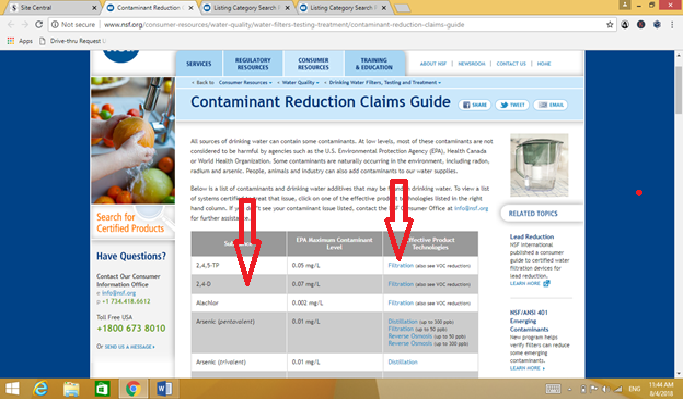
But look at the next screen shot to see what happens when you click on one of the links.
Unfortunately, once you click on a contaminant, you’re faced with a long list of options that aren’t listed by name.
For example, if you click on 2,4-D you’ll get multiple pages that look like this. In the first column you get the type of filter and a model number. So then you have to do a search to find the name of that filter.
It's really tedious and time consuming.
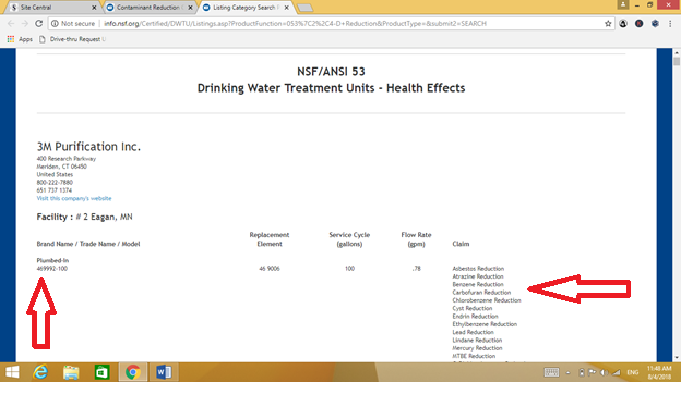
You can also use the list of Water Quality Association certified water filters to find the best one for you. This list is easier to navigate. You can click on Show Models to see brand names and the contaminants they remove.
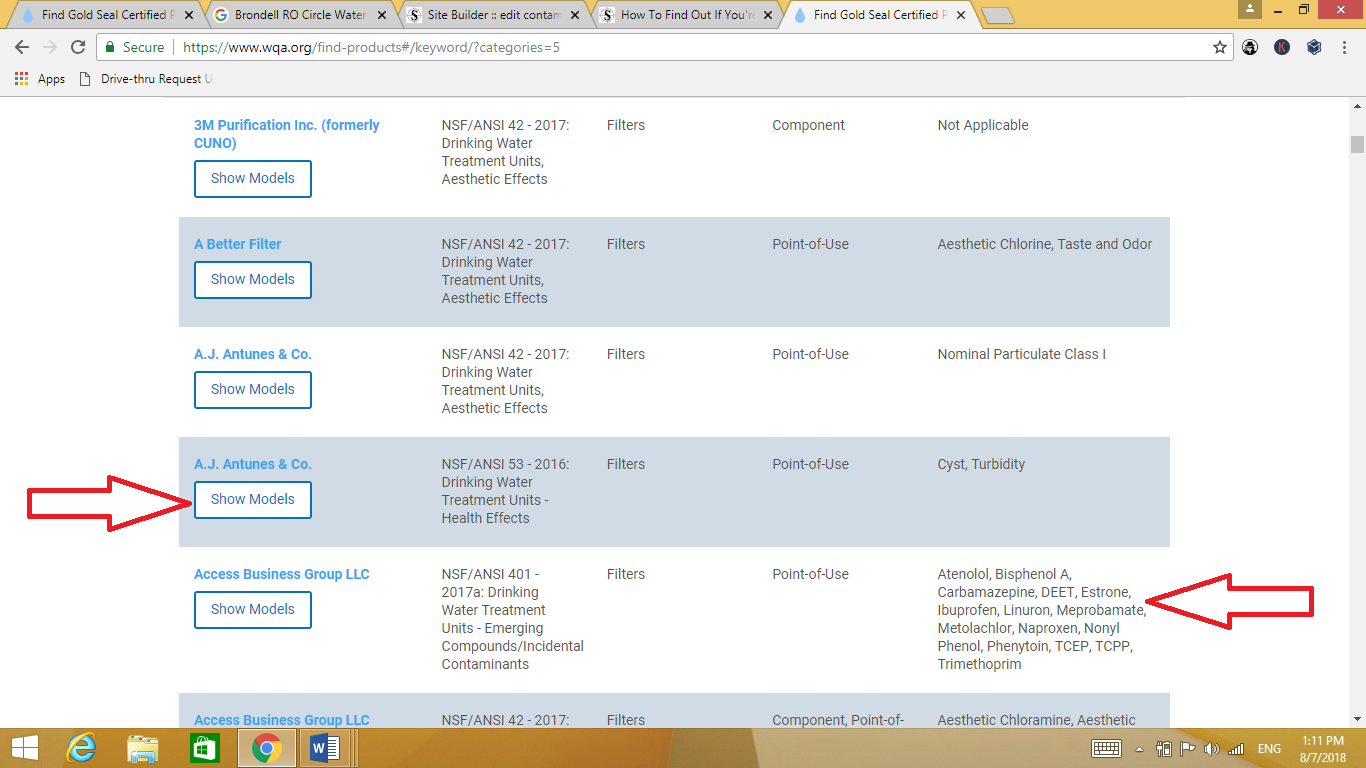
Another option is, once you’ve decided on the type of water filter system you want, visit a site like Amazon and search for the different brand options.
Then visit the websites of these brands to find a list of contaminants that are removed by the filter. Compare their list to the list of the contaminants in your water that you made. If you don't find a list, you don't want that brand.
Finally, you can also check out these articles – Common Tap Water Toxins and The Filters That Remove Them and The Best Sink Water Filters. Click here for information on water filters that remove arsenic and here for the best countertop water filters.
As a starting point here are some of my picks for filters that are great at cleaning up contaminated water.
Pitcher Filters
|
Clearly Filtered Water Pitcher Filters produce 100 gallons of water each. Filters and pitchers made in the US. Independently tested in EPA-accredited labs to meet and exceed NSF Standards for contaminant reduction. Click here for the list of over 200 contaminants that it removes. |
 |
Big Berkey Gravity Pitcher The Berkey is easy to use and the system is stainless steel. Each filter is good for 3,000 gallons. So a two-filter system will filter 6,000 gallons. If they get clogged scrub them with a brush to unclog.
Info on the specific
contaminants the system removes can be found on the Berkey website. |
 |
Faucet Mount
|
eSpring removes over 160 different water contaminants. It is NSF-certified to treat contaminants of Aesthetic Concern (Std 42), contaminants of Health Concern (Std. 53), and Emerging Contaminants/Incidental Compounds (Std 401). But, it doesn’t remove arsenic. If arsenic is a problem in your drinking water the MultiPure is a better option. |
 |
MultiPure water filters remove over 100 different water contaminants. Both the Multipure Aquadome and the Aquaversa NSF-certified to treat contaminants of Aesthetic Concern (Std 42), contaminants of Health Concern (Std. 53), and Emerging Contaminants/Incidental Compounds (Std 401). Multipure is the best option if PFOA/PFOS is a problem in your drinking water. |
 |
Under Sink
|
Epic Smart Shield | Under Sink Water Filter System
The Epic Smart is NSF certified for numerous contaminants, over 70, reasonably priced, made in the US, easy to install. |
 |
Clearly Filtered 3-Stage Under Sink Filtration System Easy to install but expensive. Filters last up to 15 months. Removes more contaminates than most under sink options, over 220. You can ind a list of contaminates it removes here. |
 |
